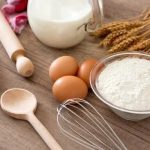Cake decorating tips are an essential tool for creating beautiful and intricate designs on cakes, cupcakes, and other desserts. However, keeping these tips clean is equally important in order to maintain their functionality and ensure food safety. In this article, we will discuss the importance of cleaning cake decorating tips and provide a step-by-step guide on how to properly clean and care for them.
Regular cleaning of cake decorating tips is crucial for several reasons. Firstly, it helps to prevent cross-contamination between different colors or flavors of icing. If not cleaned thoroughly, residue from one color or flavor can mix with another, resulting in undesirable combinations. Additionally, regular cleaning ensures that the tips remain free from any debris or dried icing that could clog the openings and affect the smoothness of your designs.
To clean cake decorating tips effectively, you will need a few basic materials. These include warm soapy water, a soft-bristle brush or small cleaning tools, vinegar or lemon (for natural cleaners), and a towel or rack for drying. By following simple steps and techniques outlined in this article, you can easily maintain the hygiene of your cake decorating tips.
In the subsequent sections, we will take you through a step-by-step guide that covers pre-cleaning methods to remove excess icing and debris, various cleaning methods suitable for different types of tips (metal vs. plastic), proper handling techniques during washing, as well as drying and storing practices to avoid rusting or corrosion.
We will also share valuable insights on maintaining the longevity of your decorative tips by establishing regular maintenance schedules and avoiding common mistakes that could damage them.
Cleaning cake decorating tips may seem like a mundane task compared to the creative activities they facilitate; however, neglecting this crucial aspect can compromise both the beauty and safety of your desserts. So let’s delve into the details on how you can keep your cake decorating tips clean and functioning at their best.
Why regular cleaning is essential for cake decorating tips
Regular cleaning is essential for cake decorating tips to ensure that they maintain their functionality and longevity. When cake decorating tips are not properly cleaned after each use, they can become clogged with dried icing or other debris, which can result in uneven or unpredictable icing flow during subsequent uses. This can significantly affect the quality and appearance of the decorated cakes.
Cleaning cake decorating tips regularly also helps to prevent the buildup of bacteria and mold, which can pose health risks when using these tools on food items. Properly cleaning and sanitizing the tips ensures that they are safe to use and helps to prevent cross-contamination between different types of icing or decorations.
Additionally, regular cleaning of cake decorating tips allows for easy removal of stains or residue from food coloring. Stains from vibrant colors can be particularly stubborn and if left untreated, can transfer onto future designs. By cleaning the tips thoroughly after each use, you can avoid unsightly discoloration on your beautifully decorated desserts.
| Benefit | Data |
|---|---|
| Enhances effectiveness and efficiency | Regular cleaning prevents clogging and ensures smooth icing flow |
| Promotes food safety | Cleaning removes bacteria and prevents cross-contamination |
| Preserves aesthetics | Cleaning removes stubborn food coloring stains for clean designs |
Materials needed for cleaning cake decorating tips
To effectively clean cake decorating tips, there are a few essential materials that you will need. Having the right tools and supplies on hand will make the cleaning process much easier and more efficient. Here is a list of the materials needed for cleaning cake decorating tips:
- Warm soapy water: This is a basic but important cleaning agent that will help to remove any leftover icing or debris from the tips. Use a mild dish soap or a specialized cleaner designed for food utensils.
- Cleaning brushes: Different types of cleaning brushes are useful for reaching into the small crevices and tight spaces of cake decorating tips. Look for brushes with soft bristles or specialized cleaning brushes specifically designed for decorating tips.
- Small cleaning tools: Alongside brushes, having small tools like toothpicks, skewers, or pipe cleaners can be helpful for dislodging stubborn clogs or removing dried-on icing.
- White vinegar or lemon juice: These natural cleaners can be used as an alternative to soapy water for extra tough stains or residues. Vinegar is especially effective at breaking down grease and removing limescale.
- Towels or drying racks: After cleaning the tips, you’ll need a way to dry them thoroughly before storing them away. Depending on personal preference, you can either air dry the tips by placing them on a clean towel or use a drying rack with specific slots to hold each tip upright.
- Storage containers: To prevent damage and keep your cake decorating tips organized, it’s important to have suitable storage containers on hand. Look for containers that have separate compartments or dividers to keep each tip securely in place and prevent them from rubbing against each other.
It’s worth noting that not all materials listed above may be necessary for every cleaning session, as it depends on the specific condition and type of cake decorating tip being cleaned. However, having these materials readily available ensures that you’ll be prepared for any cleaning task that may arise.
Step-by-step guide on how to clean cake decorating tips
Cleaning cake decorating tips is an essential step in maintaining their functionality and ensuring the production of beautiful and safe desserts. Without proper cleaning, residual icing and debris can build up on the tips, leading to clogs, uneven icing flow, and even bacterial growth. In this section, we will provide a step-by-step guide on how to effectively clean your cake decorating tips.
Pre-cleaning: Removing excess icing and debris
Before diving into the actual cleaning process, it’s important to remove any excess icing or debris from the tips. Start by scraping off any remaining icing using a spatula or the back of a spoon. Gently tap the tip against a hard surface to dislodge any trapped particles.
Cleaning methods for different types of tips
Different materials require different cleaning techniques. For metal tips, you can easily wash them with warm water and mild dish soap. Use a small brush or toothbrush to scrub away any stubborn residue. Plastic tips are best cleaned using warm soapy water as well, but be sure to avoid harsh scrubbing as plastic is more prone to scratches.
Proper handling and washing techniques
When washing your cake decorating tips, avoid using abrasive cleaners or scouring pads as they can damage delicate designs and coatings. Instead, use gentle circular motions with your cleaning tools to remove any remaining residue. Rinse thoroughly with warm water after cleaning to ensure all soap residue is removed.
Remember to also clean the couplers used with your cake decorating tips. Disassemble them carefully and clean both the inner part and the outer sleeve thoroughly.
By following this step-by-step guide for cleaning cake decorating tips, you will ensure that they are maintained in optimal condition for future use. Clean tips not only produce better results but also help prevent clogging and bacterial growth on your valuable baking tools.
Cleaning tips for stubborn stains and clogged tips
Cleaning cake decorating tips can sometimes be a challenge, especially when dealing with stubborn stains or clogged tips. However, it is important to keep your tips clean and free from any residue for optimal performance and to maintain their longevity. In this section, we will provide you with some helpful cleaning tips for handling these particular issues.
One effective method for tackling stubborn stains on cake decorating tips is soaking them in warm soapy water. Fill a bowl or sink with warm water and add a few drops of dish soap. Place the stained tips in the soapy water and let them soak for about 10-15 minutes. This will help loosen any stubborn residue, making it easier to clean off later.
For more intricate or hard-to-reach areas, using brushes or small cleaning tools can be quite useful. Toothbrushes or pipe cleaners are ideal for scrubbing away stubborn stains or debris that may be stuck in the crevices of your tips. Gently scrub the tips using circular motions until the stains are removed. Be careful not to apply too much pressure as it could cause damage to delicate metal or plastic tips.
Another alternative is using natural cleaners like vinegar or lemon juice. Both options are non-toxic and can effectively remove stains from cake decorating tips. Create a solution by mixing equal parts vinegar (or lemon juice) and water in a bowl. Soak the stained tips in this mixture for about 10-15 minutes before rinsing them thoroughly with clean water.
By following these cleaning methods, you can easily tackle stubborn stains and keep your cake decorating tips looking their best. Remember, regular cleaning is essential not only for maintaining the aesthetic appeal of your tools but also for ensuring food safety and preventing cross-contamination while working on different types of desserts.
Drying and storing cake decorating tips properly
Air drying vs. towel drying
After cleaning your cake decorating tips, there are two main methods for drying them: air drying and towel drying. Air drying involves leaving the cleaned tips out in a well-ventilated area until they are completely dry. This method is preferred as it allows any excess moisture to evaporate naturally without risking damage to the tips.
Towel drying, on the other hand, involves gently patting the cleaned tips dry with a clean towel. However, you should exercise caution with this method as using an abrasive or rough towel can cause scratches or other damage to the delicate surface of certain tips. If you choose to towel dry your cake decorating tips, use a soft, lint-free cloth or paper towel to gently absorb any remaining moisture.
Avoiding moisture retention
Moisture retention is a common cause of rust or corrosion on cake decorating tips. To prevent this, ensure that your cleaned tips are completely dry before storing them. Even a small amount of moisture can lead to oxidization over time if left unchecked.
One effective way to eliminate moisture is by allowing your cleaned tips to air dry overnight on a clean dish rack or baking sheet. Make sure that all parts of the tip are exposed to air by propping them up at an angle rather than laying them flat.
Organizational tips for storing tips safely
Proper organization of your cake decorating tips ensures that they remain in excellent condition and easily accessible when needed. There are several storage options available that allow you to keep your tips organized and protected.
One popular option is to use a tip organizer, which typically consists of a container with compartments specifically designed to hold different types and sizes of tips. These organizers often have removable trays or inserts that can be customized to fit your specific collection of tips.
Another option is to store the tips in zip-lock bags or small plastic containers. Be sure to label each bag or container with the type and size of the tip for easy identification.
By following these drying and storage guidelines, you can ensure that your cake decorating tips are in optimal condition and ready for future use. Proper maintenance of your tools not only extends their lifespan but also enhances the quality and creativity of your cake decorations.
Maintaining the longevity and functionality of cake decorating tips
To maintain the longevity of cake decorating tips, it is important to establish a regular maintenance schedule. This includes cleaning the tips after each use, even if you plan to use them again right away. Leaving icing or debris on the tips can lead to clogging or staining, which may affect the performance of the tip in future uses.
In addition to regular cleaning, it is essential to avoid common mistakes that could damage your cake decorating tips. For example, using abrasive cleaners or scrub brushes can scratch metal tips or dull plastic ones. It is best to use gentle cleaning methods and tools specifically designed for cake decorating.
Furthermore, knowing when it’s time to replace a tip is an important aspect of maintaining its functionality. Over time, all cake decorating tips will experience wear and tear resulting from use. Signs that a tip needs replacing include a loss of shape or integrity, decreased performance, or if it becomes difficult to clean even with proper care.
By following these maintenance practices, you can ensure that your cake decorating tips remain in great condition for years to come. Properly cared for tips will enable you to create stunning designs effortlessly while avoiding any potential issues like clogs or stains that may compromise your creations.
Troubleshooting common cleaning issues or challenges
Cleaning cake decorating tips can sometimes come with its own set of challenges. From stubborn food coloring stains to delicate or ornate tips, there are a few common issues that decorators may encounter when trying to clean their tips. However, with the right techniques, these challenges can be overcome effectively.
- Removing stubborn food coloring stains: Food coloring stains can be particularly tricky to remove from cake decorating tips. One effective method is to soak the stained tip in warm soapy water for about 15-30 minutes before scrubbing it with a brush or small cleaning tool. For more stubborn stains, you can try using a paste made from baking soda and water, applying it onto the stain and letting it sit for a few minutes before rinsing off.
- Avoiding cross-contamination and bacterial growth: Proper hygiene is crucial when it comes to cake decorating tips. To avoid cross-contamination and bacterial growth, it is recommended to wash your hands thoroughly before handling the tips. Additionally, make sure to wash the tips immediately after use and avoid leaving them sitting in icing for too long. Using separate brushes or small cleaning tools for each tip can also help prevent cross-contamination.
- Finding alternative cleaning solutions for delicate or ornate tips: Delicate or ornate cake decorating tips often require extra care during the cleaning process. To avoid damaging these types of tips, consider using alternative cleaning solutions such as a soft toothbrush dipped in warm soapy water or gently wiping them with a microfiber cloth dampened with a mixture of vinegar and water. Be sure to handle these intricate tips with caution and do not apply excessive force during cleaning.
By following these troubleshooting techniques, decorators will be able to address common cleaning issues and challenges they may face when maintaining their cake decorating tips. With proper care and attention, decorators can ensure that their tips remain clean, functional, and ready to create beautiful desserts.
Conclusion
In conclusion, maintaining clean cake decorating tips is crucial for creating beautiful and safe desserts. Regular cleaning not only ensures the longevity and functionality of the tips but also helps in preventing cross-contamination and bacterial growth. By following the proper cleaning methods and techniques for different types of tips, you can ensure that your cake decorating tools remain in excellent condition.
It is essential to have the right materials on hand for cleaning cake decorating tips. From warm soapy water to small cleaning tools or natural cleaners like vinegar or lemon, these items will help remove stubborn stains and unclog tips effectively. Additionally, properly drying and storing the tips are equally important to prevent moisture retention, rust, or corrosion.
To maintain the longevity and functionality of your equipment, a regular maintenance schedule is recommended. Avoiding common mistakes such as using abrasive cleaners or exposing metal tips to acidic substances will also help preserve them in good condition. Lastly, it’s important to know when it’s time to replace a tip to ensure optimal performance during cake decorating.
By following these guidelines and troubleshooting any cleaning issues or challenges that may arise, you can create stunning desserts while ensuring their safety. Clean cake decorating tips contribute to the overall success of your creations and help make every occasion more special with beautifully designed treats. So remember, always prioritize cleanliness when it comes to your cake decorating tools.

Welcome to my blog about home and family. This blog is a place where I will share my thoughts, ideas, and experiences related to these important topics. I am a stay-at-home mom with two young children. I hope you enjoy reading it! and may find some helpful tips and ideas that will make your home and family life even better!





